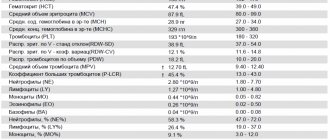Briefly about the physiology of the fetal heart
The heart is one of the very first organs that is formed in the embryo’s body.
Already at 5 weeks of pregnancy, the first heartbeats can be recorded.
This happens for one simple reason: there are cells in the heart tissue that can independently generate an impulse and cause muscle contractions. They are called pacemakers, or pacemakers. This means that the work of the fetal heart in the early stages of pregnancy is completely independent of the nervous system.
Only by the 18th week of gestation do signals from the vagus nerve arrive to the heart; its fibers are part of the parasympathetic nervous system. Thanks to the influence of the vagus nerve, the heart rate slows down.
stages of fetal heart development
And by the 27th week, the sympathetic innervation of the heart is finally formed, which leads to an acceleration of heart contractions. The influence of the sympathetic and parasympathetic nervous system on the heart is the coordinated work of two antagonists, whose signals are opposite.
Thus, after the 28th week of pregnancy, the heart rhythm is a complex system that obeys certain rules and influences.
For example, as a result of the baby’s physical activity, signals from the sympathetic nervous system predominate, which means that the heart rate accelerates. Conversely, when a baby sleeps, signals from the vagus nerve dominate, which leads to a slower heart rate. Thanks to these processes, the principle of “unity of opposites” is formed, which underlies the myocardial reflex. The essence of this phenomenon is that the work of the fetal heart in the third trimester of pregnancy depends on the motor activity of the baby, as well as the sleep-wake rhythm. Therefore, to adequately assess heart rhythm, it is necessary to take these factors into account.
It is thanks to the peculiarities of the innervation of the heart that it becomes clear why cardiotocography becomes most informative in the third trimester of pregnancy, when the work of the heart obeys certain rules and patterns.
Causes
This anomaly can be caused by various factors that contribute to excessive or, conversely, insufficient activity of the baby in the womb. The main reasons for the anomaly:
- hypotonia of the abdominal muscles;
- oligohydramnios and polyhydramnios;
- fetal hypotrophy;
- tumors of the uterus and pelvic bones;
- increased myometrial tone;
- risk of spontaneous abortion;
- large fruit;
- clinically narrow pelvis;
- multiple births;
- abnormal attachment of the placenta;
- fetal development abnormalities;
- structural defects of the uterus (bicornuate, saddle-shaped).
How does a cardiotocograph work and what does it show?
This device has the following sensors:
- Ultrasound, which detects the movements of the fetal heart valves (cardiogram);
- Tensometric, determining the tone of the uterus (tocogram);
- In addition, modern cardiac monitors are equipped with a remote control with a button that must be pressed at the moment the fetus moves. This allows you to assess the nature of the baby’s movements (actogram).
Information from these sensors enters the cardiac monitor, where it is processed and displayed on an electronic display in digital equivalent, and is also recorded by a recording device on thermal paper. The speed of the tape drive differs among different types of fetal heart monitors. However, on average, it ranges from 10 to 30 mm per minute. It is important to remember that there is special thermal paper for each cardiotocograph.
example of a CTG tape: above - fetal heartbeat, below - uterine tone values
How is cardiotocography done?
In order for this study to be informative, the following rules must be adhered to:
- CTG recording is carried out for at least 40 minutes.
It is during this time that certain patterns of rhythm changes can be traced. - A pregnant woman should lie on her side during the examination.
If a pregnant woman lies on her back during CTG registration, unreliable results may be obtained, which is associated with the development of the so-called inferior vena cava syndrome. This condition develops as a result of pressure from the pregnant uterus on the abdominal aorta and inferior vena cava, which may result in disruption of uteroplacental blood flow. Thus, if signs of hypoxia are obtained on CTG performed with the pregnant woman lying on her back, it is necessary to redo the study. - The sensor that records the fetal heartbeat must be installed in the projection of the fetal back.
Thus, the location of the sensor’s fixation depends on the position of the fetus in the womb. For example, with a cephalic presentation of the baby, the sensor must be installed below the navel, with a pelvic presentation - above the navel, with a transverse or oblique presentation - at the level of the umbilical ring. - A special gel must be applied to the sensor
to improve the conduction of the ultrasonic wave. - The second sensor (strain gauge) must be installed in the fundus of the uterus.
It is important to know that you do not need to apply gel to it. - During the study, the woman must be given a remote control with a button that must be pressed when the fetus moves.
This allows the doctor to compare rhythm changes with the baby’s motor activity.
Ultrasound
This is a common diagnostic method during pregnancy. Fetal monitoring is carried out using modern equipment. The number of planned ultrasound examinations does not exceed five times. For the first time, a woman comes to a medical facility to determine pregnancy. Subsequent ultrasounds are performed for different purposes:
- 11-13 weeks – fetal development and the condition of the placenta are assessed
- 19-21 weeks – the size of the fetus and the sex of the child are determined, the condition of the amniotic fluid is assessed
- 32-34 weeks – the baby’s weight and the condition of the umbilical cord are determined. The commensurability of the size of the baby’s head and the birth canal is also assessed.
- Ultrasound before childbirth - possible complications are identified
Transabdominal and transvaginal examinations are performed in medical institutions. In the first case, the sensor is placed on the stomach. In the second case, a special device is used, which is inserted inside.
Ultrasound is a painless method of monitoring the fetus. Its advantages include information content, a high level of security, and no need for preliminary preparation. Ultrasound examinations have been used for 40 years. During this time, no adverse effects on fetal development were identified. For this reason, the technique is successfully used in clinics. But development does not stand still. Traditional methods are being replaced by innovative solutions.
Cardiotocogram indicators
The following indicators are the most informative:
- The basal rhythm
is the main rhythm that predominates on CTG; it can be assessed only after a 30-40 minute recording. In simple words, this is a certain average value that reflects the heart rate that is characteristic of the fetus during the resting period. - Variability
is an indicator that reflects short-term changes in heartbeat from the basal rhythm. In other words, this is the difference between the basal rate and rhythm fluctuations. -
Acceleration
is an acceleration of the rhythm by more than 15 beats per minute, which lasts more than 10 seconds. - Deceleration
– rhythm slowdown more than 15 beats. per minute lasting more than 10 seconds. Decelerations, in turn, are divided according to severity into:- dip 1 – lasts up to 30 seconds, after which the baby’s heartbeat is restored.
- dip 2 – last up to 1 minute, and are characterized by high amplitude (up to 30-60 beats per minute).
- dip 3 – long lasting, more than 1 minute, with high amplitude. They are considered the most dangerous and indicate severe fetal hypoxia.
What type of CTG during pregnancy is considered normal?
An ideal cardiotocogram is characterized by the following features:
- Basal rhythm from 120 to 160 beats/min.
- There are 5 or more accelerations within 40-60 minutes of CTG recording.
- Rhythm variability ranges from 5 to 25 beats. per minute
- There is no deceleration.
However, such an ideal version of CTG is rare, and therefore the following indicators are allowed as variants of the norm:
- The lower limit of the basal rhythm is 110 per minute.
- There are short-term single decelerations, lasting no more than 10 seconds and small in amplitude (up to 20 beats), after which the rhythm is completely restored.
When is CTG considered pathological during pregnancy?
There are several pathological options for CTG:
- Silent fetal CTG
is characterized by the absence of accelerations or decelerations of the rhythm, while the basal rhythm may be in the normal range. Sometimes such a cardiotocogram is called monotonic; the graphic image of the heartbeat looks like a straight line. - Sinusoidal CTG
has the characteristic appearance of a sinusoid. At the same time, the amplitude is small, equal to 6-10 beats. per minute This type of CTG is very unfavorable and indicates severe fetal hypoxia. In rare cases, this type of CTG may appear when a pregnant woman takes narcotic or psychotropic drugs. - Lambda rhythm
is an alternation of accelerations and decelerations immediately after them. In 95% of cases, this type of CTG is the result of compression of the umbilical cord.
In addition, there are many types of CTG that are considered conditionally pathological
. They are characterized by the following signs:
- The presence of decelerations after accelerations;
- Reduced fetal motor activity;
- Insufficient amplitude and rhythm variability.
Such signs may appear when:
- Umbilical cord entanglement;
- The presence of an umbilical cord knot;
- Impaired placental blood flow;
- Fetal hypoxia;
- Baby's heart defects;
- The presence of diseases in the mother. For example, with hyperthyroidism in a pregnant woman, thyroid hormones can penetrate the placental barrier and cause rhythm disturbances in the fetus;
- Anemia of the baby (for example, with hemolytic disease associated with immunological incompatibility of the blood of the mother and fetus);
- Inflammation of the membranes (amnionitis);
- Taking certain medications. For example, Ginipral, widely used in obstetrics, can cause an increase in the baby’s rhythm.
Video “Technique for listening to the fetal heartbeat”
- Author: Polina
Hello. My name is Polina. Having once heard the truth that a pediatrician is the main doctor for any family with small children, I realized that I had something to strive for. Rate this article:
- 5
- 4
- 3
- 2
- 1
(0 votes, average: 0 out of 5)
Share with your friends!
Chlamydia during pregnancy: what does a woman need to know?
Fetal heart rate during pregnancy
What to do if CTG indicators are borderline between normal and pathological?
When registering a CTG and receiving a questionable result, you must:
- Conduct additional research methods (ultrasound, study of blood flow velocity in the uteroplacental system, determination of the biophysical profile).
- After 12 hours, repeat the CTG study.
- Avoid taking medications that may affect the baby's heart rate.
- Carry out CTG with functional tests:
- Non-stress test - consists of studying the heart rate in response to fetal movements. Normally, after the baby moves, the rhythm should speed up. The lack of acceleration after movements is an unfavorable factor.
- Stress test - characterized by a change in heart rate after administration of 0.01 units of oxytocin. Normally, after this drug enters the body of a pregnant woman, the fetal rhythm accelerates, there is no deceleration, while the basal rhythm is within acceptable limits. This indicates the high compensatory capabilities of the fetus. However, if after the administration of oxytocin the fetus does not experience accelerations, but, on the contrary, heart contractions slow down, then this indicates intrauterine hypoxia of the baby.
- A mammary test is an analogue of a stress test, but instead of administering oxytocin, the pregnant woman is asked to massage her nipples for 2 minutes. As a result, the body releases its own oxytocin. The results are evaluated in the same way as in a stress test.
- Physical stress test - a pregnant woman is asked to climb the stairs of the 2nd floor, immediately after this a CTG recording is performed. Normally, the fetal heart rate should increase.
- Breath-hold test - while recording a cardiotocogram, the pregnant woman is asked to hold her breath while inhaling, while the baby’s heart rate should decrease. Then you need to hold your breath as you exhale, after which the fetal rhythm should speed up.
Preparation for manipulation
During auscultation, the pregnant woman should be in a horizontal position, so it is advisable to have an individual sheet with you to cover the couch on which you will lie. Before visiting the antenatal clinic, you need to empty your bowels and bladder so that bowel sounds do not interfere with the examination.
And one more condition for obtaining reliable results. During auscultation, the expectant mother should be completely calm. When a pregnant woman is psycho-emotionally excited, the fetal heart rate may increase.
Phonocardiography is a modern analogue of auscultation
How is CTG scored?
To ensure that the interpretation of CTG results is not subjective, a convenient system for assessing this type of study has been developed. It is based on studying each CTG indicator and assigning certain points to it.
For ease of understanding of this system, all characteristics of CTG are summarized in the table:
| 2 points | 1 point | 0 points | |
| Basal (basic) rhythm | From 120 to 160 | From 100 to 180 | Less than 100, more than 180 |
| Amplitude | From 6 to 25 | 3-5 | < 3 |
| Variability | > 6 | 3-6 | < 3 |
| Number of acceleration episodes in 40 minutes | >5 | 1-4 | none |
| Decelerations | Not registered | Short-term | Long, heavy |
| Fetal movements | >3 | 1-2 | No |
The interpretation of the results is assessed as follows:
- CTG is considered good if it scores 9-12 points;
- A score of 6-8 points indicates signs of hypoxia; in such situations, daily monitoring and treatment are required.
- Less than 5 points is extremely unfavorable.
Important!
Pronounced pathological changes on CTG may indicate a terminal condition of the fetus. Of course, in such situations, it is absolutely impossible to carry out any functional tests. In these cases, emergency delivery may be required, since delay is very dangerous.
CTG during childbirth
Heart rate examination is necessary both in the first (cervical opening) and in the second (pushing) stages of labor. This is necessary in order to prevent acute intrauterine hypoxia, which threatens the life of the fetus and is an indication for emergency caesarean section.
It is for this reason that CTG recording must begin at the first signs of labor. During normal labor, it is enough to register a CTG every hour.
This study also shows:
- After the rupture of amniotic fluid;
- When performing epidural anesthesia during childbirth (after administration of the anesthetic).
Permanent CTG recording is necessary for conditions such as:
- Loss of umbilical cord loops;
example of indication for multiple pregnancy
Bloody discharge from the genital tract;
- Pelvic position of the fetus;
- Multiple pregnancy;
- Two- and three-fold entanglement of the umbilical cord around the fetal neck;
- Signs of gestosis;
- Diabetes;
- Yellow or green amniotic fluid;
- Hemolytic disease of the fetus;
- Intrauterine growth retardation;
- Premature birth;
- Scar on the uterus after previous operations;
- With weak or excessively strong labor.
- When inducing labor with drugs, such as Oxytocin or prostaglandins.
However, it should be remembered that CTG during pregnancy and childbirth is not the same thing.
Therefore, the interpretation of the results must be approached differently. The natural question is: why does this happen?
The fact is that during contractions the muscle fibers of the uterus contract, which means that spasm of the vessels located in the thickness of the myometrium occurs. As a result, uteroplacental blood flow deteriorates and moderate fetal hypoxia develops. During this period, the child's heartbeat may slow down or, conversely, be excessively fast. For this reason, the common phrase that “childbirth is stressful for a child” has a constructive explanation. However, after the contraction, placental blood flow is restored and the heartbeat returns to normal. In this regard, clear criteria for assessing CTG during childbirth have been developed.
Normal indicators of the birth cardiotocogram are characterized by:
- The heart rate ranges from 110 to 160 beats per minute.
- The presence of at least two episodes of rhythm acceleration (accelerations) lasting more than 15 seconds during the period of CTG registration.
- The presence of rhythm variability from 5 to 25 beats min.
- After the cervix is opened by more than 4-5 cm, early decelerations lasting no more than 30 seconds are allowed.
CTG is considered doubtful if the following signs are present:
- The rhythm is in the range from 100 to 110, or from 160 to 170 beats per minute.
- Within an hour there is not a single episode of increased heart rate.
- Low variability (less than 5 beats per minute).
- There are slowdowns in the rhythm that last from 30 to 60 seconds.
Pathological CTG is characterized by:
- The rhythm is too slow (less than 100 beats per minute) or too fast (more than 170 beats per minute).
- Prolonged episodes of deceleration, lasting more than 1 minute.
- Lack of variability, in other words, monotonous rhythm.
- The so-called sinusoidal nature of CTG, when the heartbeat graph resembles a sinusoid.
Amnioscopy
This is a visual method with which amniotic fluid is examined. It is carried out in several cases: post-term pregnancy, suspected intrauterine death of the child and prolonged labor in which the amniotic sac has not burst.
Amnioscopy is performed at a stage of pregnancy exceeding 36 weeks. During the study, the doctor evaluates the amount and color of amniotic fluid. The presence of foreign impurities is also determined. The results obtained are sent to an obstetrician-gynecologist.
Fetal monitoring using an amnioscope can detect serious abnormalities. To conduct the study, preliminary preparation is required. Amnioscopy is carried out with the consent of the woman, informed about possible complications. The probability of miscarriage or onset of premature labor after the study is 0.5%.
How does CTG influence medical tactics?
{banner_banstat9}
The results of the study must be taken seriously. The doctor who evaluates the CTG bears great responsibility. It is for this reason that each film recording cardiac activity must be evaluated by the responsible physician, certified by his signature indicating the time of the study and pasted into the birth history.
A normal cardiotocogram is a sign of correct and careful management of labor.
When receiving a questionable CTG, the doctor has no more than 40 minutes to correct labor activity. At this stage, it is necessary to eliminate all risk factors leading to hypoxia:
- Stop administering “oxytocin” and prostaglandin-based drugs;
- Explain to the woman how to breathe correctly during contractions;
- Determine the position of the fetus and exclude compression of the umbilical cord;
- Perform an ultrasound to exclude incipient placental abruption;
- Administer drugs that improve the rheological properties of blood.
Poor CTG is a good reason to change delivery tactics in favor of emergency cesarean section,
or eliminate the causes of acute hypoxia. Ignoring pathological CTG is absolutely unacceptable, because this can cause fetal death.
In other words, CTG is a serious tool in the hands of an obstetrician.
Dopplerography
This is a type of ultrasound examination. With its help, the state of the child’s cardiac activity is determined and the patency of the umbilical cord vessels is assessed. This diagnostic method gives significant results. A qualified specialist determines the presence of hypoxia, detects entanglement of the fetus with the umbilical cord and identifies abnormalities in the functioning of the placenta.
No preliminary preparation is required to conduct the study. Most ultrasound machines are equipped with a Doppler function. The procedure is absolutely painless. It lasts 15 minutes. The study is prescribed to women in the third semester of pregnancy.
The accuracy of detecting disorders using Doppler sonography is 70%. The absence of problems in a specific period of time does not exclude the development of complications in later stages.
conclusions
{banner_banstat10}
Cardiotocography is rightfully one of the most widely used studies in obstetrics. However, like any other technique, it is effective only if it is applied correctly (in accordance with all standards), as well as with proper interpretation of the results obtained.
Unfortunately, there are still disputes and different interpretations of some complex and dubious cases. For this reason, we should not forget that there are also additional research methods that can either confirm or refute possible concerns.
In addition, CTG results remain relevant and informative for no more than 1 week, which means that the key to a favorable pregnancy is regular monitoring of the condition of the fetus.











